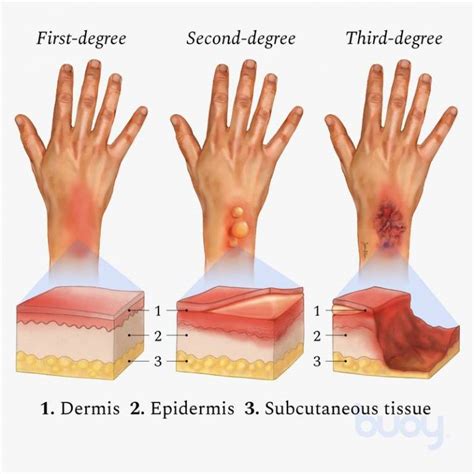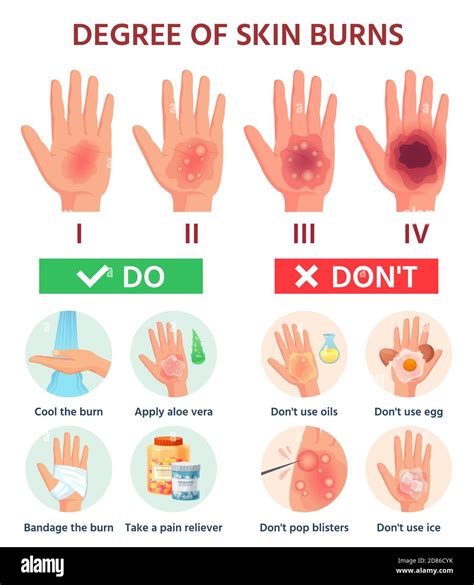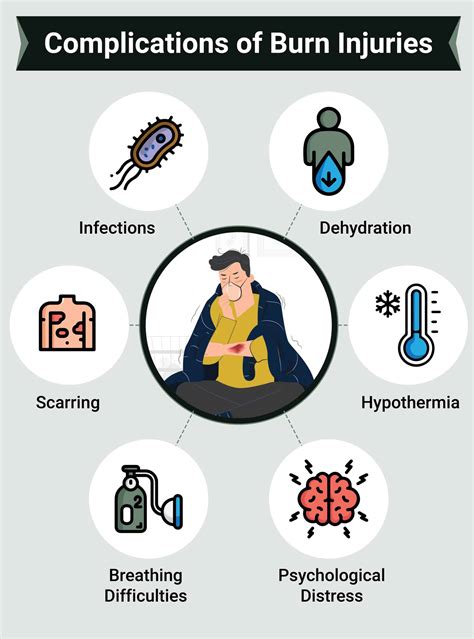Intro
Discover 5 common ways second degree burns occur, including scalds, flames, and electrical accidents, and learn prevention tips to avoid these painful injuries, promoting burn care and wound healing.
Second degree burns are a type of burn injury that affects both the outer layer of skin (epidermis) and the layer beneath (dermis). These burns can be painful, take time to heal, and may leave scars. Understanding how second degree burns happen is crucial for prevention and proper treatment. Second degree burns can occur in various situations, and being aware of these scenarios can help individuals take necessary precautions to avoid such injuries.
Second degree burns are more severe than first degree burns, which only affect the outer layer of skin, but less severe than third degree burns, which extend into deeper tissues. The severity of a burn is determined by its depth, size, and the body part affected. Second degree burns are characterized by blisters, redness, swelling, and pain. They can be further divided into two categories: superficial second degree burns, which affect the upper part of the dermis, and deep second degree burns, which extend into the deeper part of the dermis.
The importance of understanding the causes of second degree burns cannot be overstated. By recognizing the common scenarios in which these burns occur, individuals can take proactive steps to prevent them. Prevention is key, as treating second degree burns can be a lengthy and sometimes costly process. Moreover, preventing such injuries reduces the risk of infection and scarring, promoting overall health and well-being.
Introduction to Second Degree Burns

Second degree burns can happen in a variety of situations, including accidents at home, workplace injuries, or during outdoor activities. The causes can be broadly categorized into thermal, electrical, chemical, and radiation burns. Each type of burn has its unique characteristics and treatment approaches. For instance, thermal burns, which are the most common type, can result from contact with fire, hot liquids, or steam. Electrical burns occur when a person comes into contact with an electrical current, while chemical burns are caused by caustic substances. Radiation burns, though less common, can occur due to prolonged exposure to the sun or radiation therapy.
Causes of Second Degree Burns

Understanding the causes of second degree burns is the first step towards prevention. Here are five common ways second degree burns can happen:
- Scalds from Hot Liquids: Scalds are the most common type of burn injury and can happen when hot liquids, such as coffee or soup, accidentally spill onto the skin.
- Flames: Direct contact with flames from fires, whether from cooking, candles, or other sources, can cause severe second degree burns.
- Electrical Accidents: Coming into contact with live electrical sources can cause electrical burns, which may appear minor on the surface but can be severe internally.
- Chemical Exposure: Caustic chemicals found in cleaning products or industrial settings can cause chemical burns upon contact with the skin.
- Sun Exposure: Prolonged exposure to the sun without proper protection can lead to sunburn, which in severe cases can result in second degree burns.
Prevention Strategies
Preventing second degree burns involves a combination of awareness, caution, and the use of protective measures. For example, in the kitchen, it's essential to handle hot dishes and liquids with care, and to keep children away from cooking areas. In workplaces where electrical or chemical hazards are present, following safety protocols and wearing protective gear is crucial. When spending time outdoors, especially during peak sun hours, using sunscreen, wearing protective clothing, and seeking shade can prevent sunburns.Treatment and Care for Second Degree Burns

The treatment for second degree burns aims to promote healing, prevent infection, and minimize scarring. Immediate first aid involves cooling the burn with cool (not cold) water to reduce the temperature of the skin and ease the pain. Removing any clothing or jewelry near the burned area is also important, as these can stick to the burn as it heals. Applying a topical antibiotic ointment and covering the burn with a non-stick bandage can help prevent infection. For more severe burns or those that cover a large body area, medical attention is necessary.
Healing Process
The healing process for second degree burns can take several weeks. During this time, it's crucial to keep the burn clean and moist to promote healing and reduce the risk of scarring. Regular follow-ups with a healthcare provider are necessary to monitor the healing progress and address any complications early. In some cases, physical therapy may be recommended to maintain range of motion and prevent contractures, especially if the burn occurs over a joint.Complications and Long-term Effects

While second degree burns can heal with proper care, there are potential complications and long-term effects to consider. Infection is a significant risk, as bacteria can penetrate the broken skin and cause infection. Scarring is another common outcome, with deeper burns more likely to result in hypertrophic or keloid scars. In severe cases, especially in children or the elderly, burns can lead to dehydration and heat stress due to fluid loss.
Psychological Impact
The psychological impact of second degree burns should not be underestimated. The pain, disfigurement, and prolonged healing process can lead to anxiety, depression, and post-traumatic stress disorder (PTSD) in some individuals. Support from family, friends, and mental health professionals can play a vital role in recovery, helping individuals cope with the emotional and psychological aspects of their injury.Prevention and Safety Measures

Preventing second degree burns requires a proactive approach. In the home, this includes installing smoke detectors, keeping emergency phone numbers handy, and ensuring that children are supervised, especially in areas where hot liquids or open flames are present. In the workplace, adhering to safety protocols, wearing protective gear, and participating in regular safety training can significantly reduce the risk of burn injuries.
Community Awareness
Raising community awareness about burn prevention and the importance of immediate and proper care for burns is essential. Educational programs, public awareness campaigns, and community events can help disseminate information on burn prevention and first aid. By working together, communities can reduce the incidence of second degree burns and support those who have suffered from such injuries.Future Directions in Burn Care

Advancements in burn care are continually evolving, with research focusing on improving healing outcomes, reducing scarring, and enhancing the quality of life for burn survivors. New technologies, such as bioengineered skin substitutes and laser therapy for scar management, hold promise for the future of burn treatment. Additionally, there is a growing emphasis on the psychological and social rehabilitation of burn patients, recognizing the holistic impact of burn injuries.
Innovations in Burn Treatment
Innovations in burn treatment include the development of new topical treatments that can accelerate healing and reduce the risk of infection. Stem cell therapy is also being explored for its potential to improve wound healing and minimize scarring. Furthermore, telemedicine is becoming increasingly important in burn care, allowing for remote consultations and monitoring, which can be particularly beneficial for patients in remote areas or those with mobility issues.What are the signs and symptoms of second degree burns?
+Signs and symptoms include blisters, redness, swelling, and pain. The burn area may appear white or splotchy and will be sensitive to touch.
How can second degree burns be prevented?
+Prevention involves being cautious with hot liquids and open flames, using protective gear in hazardous environments, and taking sun protection measures.
What is the appropriate first aid for second degree burns?
+Immediate first aid includes cooling the burn with cool water, removing nearby clothing and jewelry, applying a topical antibiotic ointment, and covering the burn with a non-stick bandage.
As we conclude our exploration of second degree burns, it's clear that understanding their causes, prevention strategies, treatment options, and potential complications is essential for promoting health and safety. By sharing this knowledge and encouraging open discussions about burn prevention and care, we can work towards reducing the incidence of second degree burns and supporting those affected by such injuries. If you have personal experiences or questions regarding second degree burns, we invite you to share your thoughts and engage in a constructive dialogue. Together, we can foster a community that prioritizes safety, health, and well-being.
